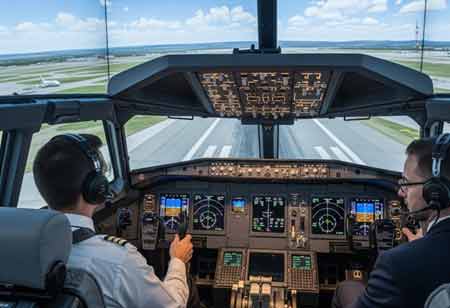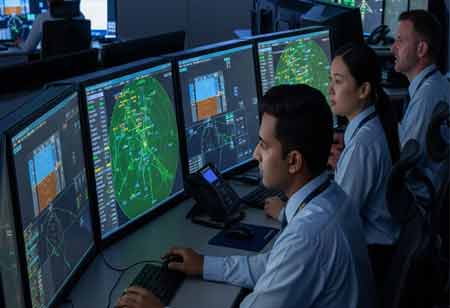Flight simulation training service in Europe has become an essential pillar of aviation readiness, shaping how pilots, operators, and regulators approach safety, efficiency, and sustainability. With airspace among the most complex and regulated in the world, reliance on high-fidelity simulators ensures that crews adapt to evolving technologies, new aircraft platforms, and emerging operational demands without compromising safety.
The sector is streamlining training pipelines and also aligning with the overarching goals of environmental stewardship and digital integration. By combining immersive realism, competency-driven curricula, and data-informed insights, flight simulation stands as a cornerstone of aviation development, enabling operators across commercial, business, and defence aviation to sustain proficiency and prepare for the future of European skies.
Evolving Market Dynamics Across European Simulation
Flight simulation training service in Europe is advancing as airlines, business aviation operators, and defence organisations seek standardised proficiency across a dense and highly regulated airspace. Demand concentrates on full-flight and fixed-base devices that mirror modern flight decks, complex avionics suites, and increasingly automated procedures. Training centres align their offerings with competency-based and evidence-driven curricula, emphasising scenario diversity, threat and error management, and resilient decision-making. As fleets transition toward more fuel-efficient airframes, simulators that reflect new flight control laws, flight management interfaces, and performance envelopes become strategic assets for both initial and recurrent qualification.
A defining pattern is the integration of data into the training loop. Providers capture granular performance metrics during sessions, synthesise them into dashboards, and feed insights back into course design. This enables targeted remediation and accelerates proficiency while supporting regulators with auditable evidence. Networked training across multiple locations is also expanding, allowing distributed crews to practice shared procedures and abnormal events in synchronised virtual environments. The result is harmonised standards across borders and more efficient capacity utilisation for operators with multi-base footprints.
Sustainability considerations are reshaping demand. Sim-centric programs reduce fuel burn and emissions associated with airborne training, while centres invest in energy-efficient facilities and device power management. European stakeholders increasingly assess training pipelines through the lens of environmental stewardship, and simulation's ability to replace most in-air checks strengthens its position as a cornerstone of responsible growth. Parallel emphasis on safety reinforces this trajectory, as high-fidelity devices permit repetition of rare, high-risk scenarios without operational exposure.
Upskilling for novel airspace users is another vector. Urban and regional air mobility concepts, advanced rotorcraft, and optionally piloted platforms require new operating philosophies and human-machine interaction patterns. Simulation is becoming the proving ground for these procedures, stitching together air traffic integration, vertiport operations, and contingency management into coherent training paths. By bridging legacy operations with emerging paradigms, European providers position themselves as enablers of airspace evolution.
Operational Hurdles and Targeted Remedies
Capacity constraints can limit access to high-fidelity devices during peak training cycles, creating scheduling pressure for operators. The remedy pairs dynamic rostering with modular syllabi that shift prerequisite learning to fixed-base trainers and virtual classrooms, reserving full-flight time for manoeuvres that demand motion and visual cues. Load balancing across multi-country networks further smooths demand, while remote examiner oversight expands assessment windows without compromising integrity.
Regulatory complexity across jurisdictions may slow course approvals or create duplication of effort. Providers address this by maintaining multi-authority qualification for devices and syllabi, mapping each lesson to harmonised competency frameworks, and implementing digital compliance repositories that streamline audits. Continuous dialogue with national authorities and pan-European bodies ensures early alignment on emerging requirements, reducing rework while preserving rigorous standards.
Technological obsolescence can erode training relevance as avionics and procedures evolve. To counter this, centres adopt open, modular simulator architectures that support rapid software drops, interchangeable panels, and upgradable visual and computing subsystems. A structured change-management process validates updates through regression testing and instructor sign-off before operational release, keeping fidelity current without prolonged downtime.
Instructor workload and variation in coaching quality may dilute outcomes if not managed deliberately. The solution establishes a faculty development pipeline with calibration flights, peer observation, and standardised grading rubrics anchored in evidence-based training. Analytics from session recordings highlight coaching consistency, while instructor rotation through line operations or safety departments sustains real-world currency that enriches debriefs.
Cybersecurity presents a growing concern as devices and learning platforms connect to enterprise networks. Providers harden infrastructure with segmented architectures, rigorous access control, and continuous monitoring, complemented by routine penetration testing and patch management aligned to aviation safety constraints. Incident response playbooks tailored to simulator environments ensure operational continuity and regulatory notification discipline.
Growth Pathways and Innovative Enhancements Benefiting Stakeholders
Simulation ecosystems in Europe are embracing immersive technologies that sharpen realism and broaden training scope. Advanced visual systems render complex terrain, adverse weather, and dense traffic with photometric accuracy, while dynamic light modelling improves depth perception during low-visibility operations. Motion cueing tuned by biomechanical research enhances kinesthetic fidelity, allowing precise training in upset prevention, energy management, and low-altitude manoeuvring. Stakeholders gain safer operations and reduced line-check failure rates as critical skills are embedded more deeply.
AI-enabled analytics are transforming how proficiency is measured and maintained. Machine learning models detect micro-patterns in control inputs, eye-tracking, callouts, and crew coordination, correlating them with scenario outcomes. This yields individualised learning prescriptions that direct each pilot to the most impactful practice segments. For airlines and operators, fleet-level heat maps reveal systemic gaps, informing recurrent syllabi and safety campaigns with objective evidence rather than anecdote.
Distributed training architectures are unlocking new efficiencies. High-fidelity simulators, fixed-base trainers, and mixed-reality devices interoperate through standard scenario engines, enabling continuous progression from procedural rehearsal to full-motion execution. Remote instructor stations monitor multiple sessions simultaneously and can inject dynamic events, providing real-time coaching while preserving resource utilisation. For smaller operators, access to this ecosystem through subscription models democratises high-end capability without prohibitive capital expenditure.









